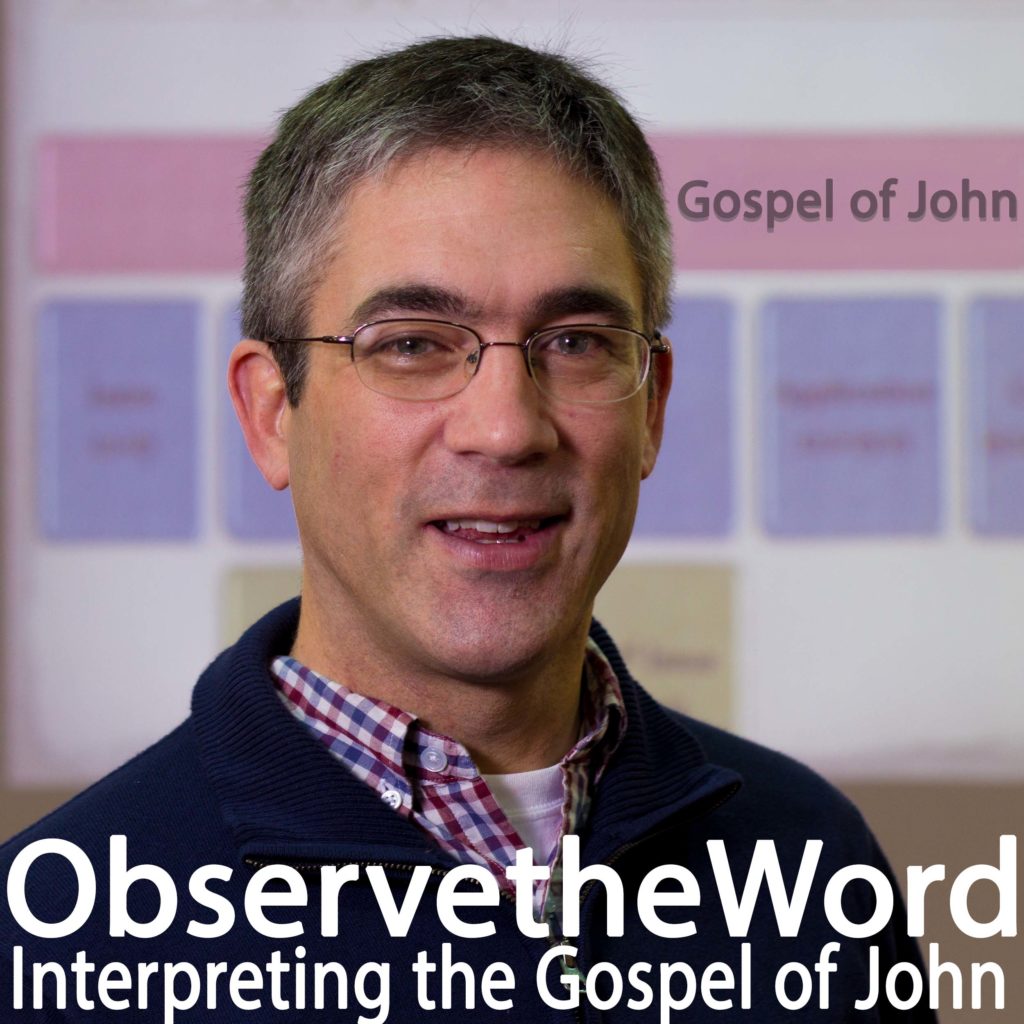Interpreting the Gospel of John

John himself gives us the purpose of his gospel, “these things have been written that you may believe that Jesus is the Christ, the son of God, and that believing you may have life in his name (John 20:31).” In this series, Bible teacher Michael Brent guides listeners through the structure and thought of the Gospel of John, delving into John’s primary themes – the nature of Jesus Christ, the nature of saving faith, and the nature of true discipleship.
| Prologue and Introduction (John 1) |
| 1. Prologue |
In John 1:1-18, we follow the chiastic structure of John’s prologue to consider the major themes that will play out in his gospel, regarding the nature of Jesus, the nature of faith, and the nature of discipleship. |
| 2. Introduction |
In John 1:19-51, we start by considering the overall structure of day before moving on to the four days of witness described in this introduction to the narrative. |
| Jesus Reveals Himself (John 2-4) |
| 3. Revealed: Water to Wine |
In John 2:1-12, we begin part 1 section 1 Jesus Revealed with the first sign which was performed at a wedding in Cana. We consider both the big obvious lettering on the sign and also the smaller, easier to miss lettering. |
| 4. Revealed: Multitude at the Passover |
In John 2:13-25, Jesus clears out the temple revealing truth about himself and motivating three different responses from Jewish leaders, his disciples, and people in the crowd. |
| 5. Revealed: Conversation with Nicodemus |
In John 3:1-21, an influential, religious leader comes to Jesus at night, and though he has everything going for him, he cannot see the light Jesus reveals. But maybe we can. |
| 6. Revealed: Witness of John the Baptist |
In John 3:22-36, we reconsider symmetry in the structure of John. We also focus in on the center of chapters 2-4, the second testimony from John the Baptist, and apply that testimony as a heart check to our own service for God. |
| 7. Revealed: Conversation with a Samaritan Woman 1 |
In John 4:1-26, we listen in and learn from Jesus Christ principles for sharing the good news. |
| 8. Revealed: Conversation with a Samaritan Woman 2 |
In John 4:27-42, we consider the effect of Jesus’ gospel conversation on the Samaritan woman, the disciples and the Samaritan villagers. |
| 9. Revealed: Healing the Nobleman's Son |
In John 4:43-54, Jesus is received without being received just as in chapter 2 many had believed without believing. The harvest field does not appear to be as white in Galilee as it was in Samaria. Still, the nobleman and his household indicate there are some in Galilee who truly believe. |
| Jesus Challenges the Darkness (John 5-10) |
| 10. Resisted: Healing of the Lame Man and Equality with God |
In John 5:1-30, we listen to Jesus’ speech after the healing of a lame man and ask, “Is Jesus really claiming to be equal with God in power and authority? And if so, what does that mean about the nature of God?” |
| 11. Resisted: Equality with God and Valid Witnesses |
In John 5:31-47, Jesus calls four witnesses to support his claim of equality with God. |
| 12. Resisted: I am the Bread of Life |
In John 6:1-51, Jesus performs an astonishing sign, but the masses following him resist what he offers them, insisting instead that he give them what they want. This raises a key question of faith. What do you want from Jesus? |
| 13. Resisted: Eat My Flesh and Drink My Blood |
In John 6:52-71 we consider the second part of Jesus’ dialogue with the crowd centered on his declaration, “I am the bread of life.” Jesus offends the crowd and many disciples depart. What is Jesus doing? What do his words mean? |
| 14. Resisted: The Feast of Booths and Living Water |
In John 7 we consider the symbolism of the Jewish Feasts in the Gospel and specifically the symbolism of the Feast of Booths as it applies to Jesus’ teaching in the temple, the debate of the people and the response of the leaders. |
| 15. Resisted: Text Criticism and A Passage in Search of a Home |
In John 7:53-8:11 we consider a known but rarely talked about issue with a cherished passage that does not seem to belong where it is located. The problem of this story will give us an opportunity to introduce the important study of identifying the original words of Scripture. |
| 16. Resisted: The Feast of Booths and the Light of the World |
In John 8:12-59 we continue the dialogue between Jesus and the Jewish crowd at the Feast of Booths as Jesus shines light on his own nature and theirs. |
| 17. Resisted: The Light of the World and the Blindness of Men |
In John 9 Jesus again declares, “I am the light of the world!” Paired to this declaration, he gives us a sign and concludes with these words, “If you were blind, you would have no sin; but since you say, ‘We see,’ your sin remains.” |
| 18. Resisted: True Leadership and Valid Witnesses |
In John 10 Jesus follows up the sign of healing the blind man with teaching about himself as the Door of the Sheep and the Good Shepherd. This lesson ends the second major section of the Gospel, chapters 5-10. |
| 19. Transition: I am the Resurrection and the Life |
In John 11 Jesus provides a sign that points directly to himself as the Resurrection and the Life. He raises Lazarus from the dead to affirm the truth that life in this world is experienced through walking with him and life in the next becomes a reality through believing in him. |
| 20. Transition: The Hour of Glory Has Come |
In John 12 Jesus declares, “the hour has come for the Son of Man to be glorified.” This is the conclusion to the first half of the Gospel (chapters 2-12, The Word Among Us) and, at the same time, the introduction to the second half of the Gospel (chapters 13-20, The Hour of His Glory). |
| Jesus Prepares His Disciples (John 13-17) |
| 21. Prepared: Jesus Sanctifies His Disciples |
In John 13:1-20 we begin the section of John’s Gospel that focuses on true discipleship with three lessons from Jesus’ symbolic act of washing his disciples’ feet. |
| 22. Prepared: A New Commandment |
In John 13:21-38 Jesus issues a new commandment for his disciples to love one another even as he has loved them. The command comes in a somber atmosphere as Jesus announces his plan to leave the disciples and foretells of his betrayal and denial. |
| 23. Prepared: Jesus Comforts His Disciples |
In John 14 while comforting his disciples Jesus further develops the nature of discipleship, emphasizing the message of the disciple and the submission of the disciple. |
| 24. Prepared: The Promised Holy Spirit |
In John 14:16-31 and John 16:5-15 Jesus we consider the promise of Jesus to send the Holy Spirit, who is the promised Holy Spirit and what roles does the Holy Spirit fulfill in the lives of believers. |
| 25. Prepared: Abiding in Christ |
In John 15 Jesus provides for us the simple and deep discipleship image of the vine and the branches. We will consider the heart of abiding in Christ, the acts of abiding in Christ and the fruit of abiding in Christ. |
| 26. Prepared: The Fruit that Remains |
In John 15:12-17, we recognize the fundamentals of discipleship as abiding and loving while also addressing what Jesus meant when he said, “you will do greater works.” |
| 27. Prepared: Witness in the World |
In John 15:18-16:15, we consider the disciple’s relationship to the world as both separate from the world and also committed to engagement with the world in the power of the Holy Spirit. |
| 28. Prepared: Ask the Father in My Name |
In John 16:16-33, in the midst of the disciples’ confusion, we are compelled to address the nature of prayer as Jesus promises for the fourth time, “If you shall ask the Father for anything, he will give it to you in My name.” |
| 29. Prepared: Jesus Prays for His Glory |
In John 17:1-5, Jesus begins his prayer of sanctification for New Testament believers with a prayer for his own glory. How does God’s desire for his own glory relate to his pursuit of a people called by his name? |
| 30. Prepared: Jesus Prays for His Disciples |
In John 17:6-19, Jesus makes three prayer requests for his disciples as he commissions them to go into the world though not be of the world. If Jesus were to pray for you, what would he ask for? |
| 31. Prepared: Jesus Prays for Us |
In John 17:20-26, Jesus prays for us, for all who will believe because of the apostles’ witness, and as he prays, Jesus describes his vision for unity and witness in Christian communities based on the truth of God’s name and reality of abiding in him. |
| Jesus Lifted Up (John 18-20) |
| 32. Lifted Up: The Arrest of Jesus |
In John 18:1-27, we begin the story of Jesus’ final hour with John’s depiction of his arrest and first trial. Adding to the witness of the other Gospels, John reminds us that Jesus may go to the cross meekly, but he is absolutely not weak. Jesus maintains control throughout. |
| 33. Lifted Up: The Trial of Jesus |
In John 18:28-19:16, the trial of Jesus turns into an honor/shame struggle between the Roman governor and Jewish officials who both misunderstand who is truly in control of events. |
| 34. Lifted Up: The Crucifixion and Burial of Jesus |
In John 19:17-42, Jesus reverses the shame of the cross to magnify the glory of his name, providing for us not only forgiveness but also a new status of honor free from guilt and shame. |
| 35. Lifted Up: The Empty Tomb and Risen Lord |
In John 20, the responses of believers to the empty tomb and news of Jesus raised from the dead suggest principles of faith in line with the two great themes of John’s Gospel. |
| Epilogue (John 21) |
| 36. Epilogue: The Journey of Faith |
In John 21, the epilogue of the Gospel, John directs our attention to the journey of faith, highlighting the restoration of Peter and the commission Jesus gives every believer, “Follow me.” |
